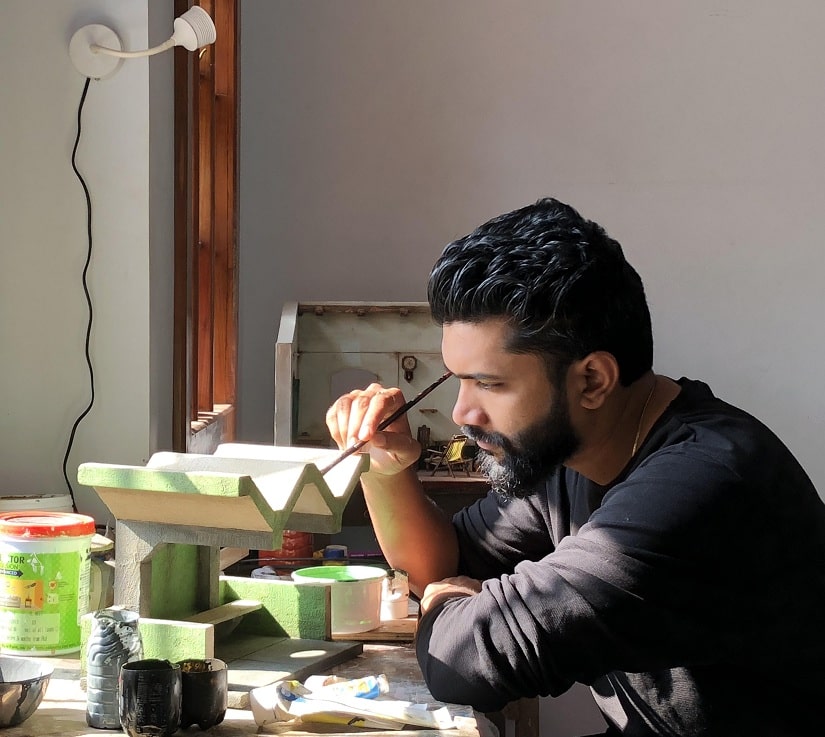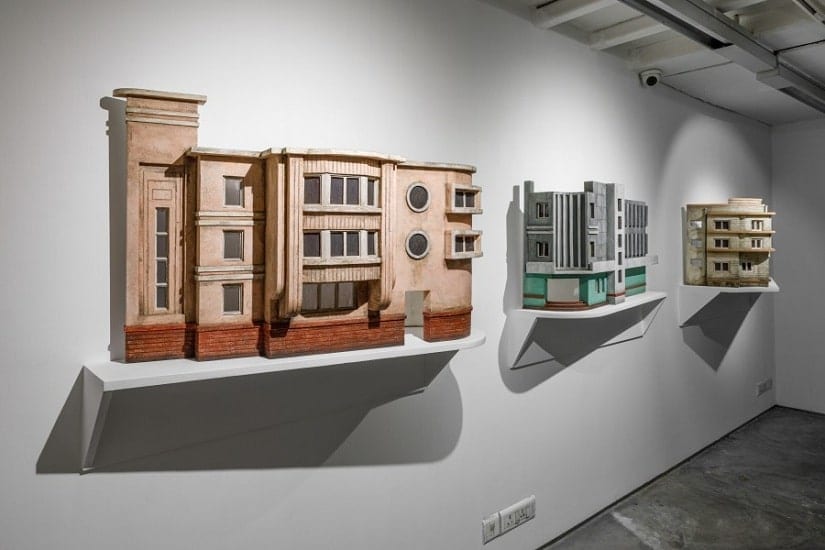Experimenter gallery’s new exhibition responds to the way contemporary architecture is being appropriated in India, where an emboldened political class has set out to rewrite histories and legacies. Titled Monuments, Mausoleums, Memorials, Modernism, the exhibition brings together a new collection of sculptures and paper-based works by Sahil Naik, whose practice has been shaped by themes related to the built environment in South Asia and other parts of the world. His new exhibition is part of a chorus of voices speaking against the trampling of alternate discourses in a saffronised landscape — a phenomenon that has, in India, affected the evolution of architecture as well. Case in point is a recent exhibition by the Kiran Nadar Museum of Art, which traces the career of well-known engineer Mahendra Raj and his contribution to several modernist projects, including the Hall of Nations, New Delhi, which was demolished in 2017. Naik’s exhibits serve as architectural propositions at a time India witnesses dramatic changes to its built environment. These changes are taking place as landmark buildings (such as the Hall of Nations) — that have either colonial or post-independence significance — are being demolished, modified or simply ignored. In this conversation, the Goa-based artist, who studied sculpture at The Maharaja Sayajirao University, Baroda and Goa College of Art, talks about the triggers for his new work, ranging from the question of erasure in architecture planning to the building of a dam in Goa that submerged a village. Your new project is a response to the way architecture is being appropriated in contemporary times – a concern quite relevant to India. Can you talk about your own position on this subject, with specific examples? We are at a crucial moment where historical narratives are being constantly appropriated and there is a concentrated effort towards erasure. We are looking at new plans of redevelopment and social housing, demolition of ‘unstable’ buildings; new museums, memorials, trade centres, etc. This doing over of what we already have, has my interest. It amuses me how much legacy can mean in the narrative of national histories. The other is, of course, the claim of development and modernisation. [caption id=“attachment_8066771” align=“alignnone” width=“825”]  Sahil Naik at his studio. Image courtesy: Experimenter gallery, Kolkata.[/caption] Closer to home, Charles Correa’s Kala Academy, an excellent example of public and cultural architecture that speaks to the climate of Goa, was threatened with partial demolition. The open-air theatre was damaged and instead of renovation/repair, a tearing down was announced. It was only after local uproar and the intervention of the High Court of Bombay at Goa that this was stalled. But several other buildings did not share this fate, like the Nazarbaug Palace in Baroda that was demolished to build a shopping centre or the Hall of Nations in New Delhi. How did the idea behind the exhibition come about, and how did you approach the works, in terms of your process? In the 1960s, Dayanand Bandodkar, the first chief minister of Goa presented his dream of building a modernist dam at Salaulim in Goa. The dam was eventually built, and it submerged the village of Curdi, amongst others, and displaced thousands of people. Every year in the summer, when waters of the reservoir recede, the village resurfaces and people return to visit what remains of their homes. I have been returning to Curdi every summer for many years. For me, this was in many ways a starting point for this project. Monuments, Mausoleums, Memorials, Modernism really started in 2015. The project began with putting together material from diverse sources collected over the past four years. These include archival material, news clippings, material from the internet, social media and images/drawings from my own field trips. I began looking at post-independence architecture – the challenges, strategies and intentions – in new nations or recently liberated nations. I was thinking through the intentions of the state for her citizens through social housing, cooperatives and government buildings, parks, museums, banks and schools in the first two decades of independent India. The approach was simple – to constantly measure ambition with function, and through the citizen. [caption id="" align=“alignnone” width=“825”]  Installation view of Sahil Naik’s new solo, Monuments, Mausoleums, Memorials, Modernism. Image courtesy: Experimenter gallery, Kolkata.[/caption] Your sculptures and paper works are a nod to the nostalgia towards modernist architecture, which is being revisited by artists and historians as India witnesses large-scale political changes to its built environment. In terms of the creative influences for this exhibition, are there any important architects or landmarks who/which may have informed your recent work? I, on the contrary, think this project is not about the nostalgia of modernist architecture. It is instead critical of this nostalgia. It does instead think about the violence of the nation-building project, function and subjects in waiting. The ambition of Nehruvian modernism did little to bridge the distance between the large number of incoming refugees and the pace of construction. Having said that, there is a lot to admire in the modernist project as well, most importantly its attempt to provide security and a forward-thinking attitude. There was something strangely congregational about the architecture, that enabled a kind of community building. We are faced by another kind of violence today – one of rewriting – a show of power that constantly compromises people, culture and resources. There are several architects and their works I am thinking about right now. Some of these would be Perin Mistri’s St Stephen’s Church on Nepean Sea Road, Mumbai; Charles Correa’s Goa Kala Academy; Minnette de Silva’s Senanayake Flats in Colombo; Muzharul Islam’s Faculty of Fine Arts in Dhaka, and the National Museum of Natural History in New Delhi, which was gutted in a blaze in 2016. You live and work in Goa, a state with its own history of appropriation of architecture, such as its temples, which represent a hybrid artistic influence both Indian and foreign. How has life in Goa shaped your own approach to architecture as an artist? The architectural history of Goa is fraught with assimilation. The history of temple architecture, for example, can be traced to cave temples dedicated to nature Gods, which were carved out of red laterite, that later followed the standard temple layout. Over the years, with different rulers and cultural influences of several features — like a basilican floorplan from the churches, the Bijapuri domes and the stepped tank reminiscent of the Adilshahi Goan mosques — were assimilated into the state’s architecture. In terms of housing and social architecture, the Portuguese were fast losing resources by the 18th century. So the ambition of Goan architecture was mostly homegrown and led by natives. They worked with local skill sets, materials and crafts to create an architectural style truly unique to the region. I say Goan architecture because the term ‘Portuguese architecture’ is grossly inaccurate. Goa had its first multi-storeyed building in the Mandovi Hotel at Panaji, which was built to cater to the influx of visitors expected to attend the exposition of St Francis Xavier in 1952. Since there were no architects in Goa at that time, the hotel brought them in from Bombay, who were influenced by the Art Deco style. Growing up in Goa, all of these stories have had a deep influence on me, and they play out as simple fascinations or anecdotes in my work. I believe a large part of the conversations around architecture, particularly modernist architecture, is about form and aesthetics. I am more interested in the narrative and the anecdotal, a kind of humanising of architecture. Monuments, Mausoleums, Memorials, Modernism runs from 8 Jan - 25 Feb at Experimenter, Hindustan Road, Kolkata.
Sahil Naik’s exhibition speaks against the trampling of alternate discourses in a saffronised landscape — a phenomenon that has affected architecture as well.
Advertisement
End of Article


)
)
)
)
)
)
)
)
)



